Business Law and Ethics Report: Blackburn Case Identification Evidence
VerifiedAdded on 2020/04/01
|9
|2092
|289
Report
AI Summary
This report analyzes the case of Mr. Harold Blackburn, focusing on the identification evidence presented against him in relation to charges including rape. The report delves into the definition of identification evidence and the role of tactical intelligence in the investigation, particularly the actions of the Senior Sergeant. It examines the evidences gathered, including photographic identifications, forensic reports, and witness testimonies, highlighting inconsistencies and potential failures in the investigation process. The analysis considers the admissibility of evidence, the reliability of witness identifications, and the impact of forensic findings, such as blood group discrepancies. The report references relevant legal precedents like R. v Alexander and concludes that the evidence presented against Mr. Blackburn was partially admitted and the evidence collected by the police in case of the rape matter were not sufficient. The report also examines the interference of the Chief Inspector of Police and questions the strength of the evidence, thereby raising concerns about the overall admissibility of the evidence.
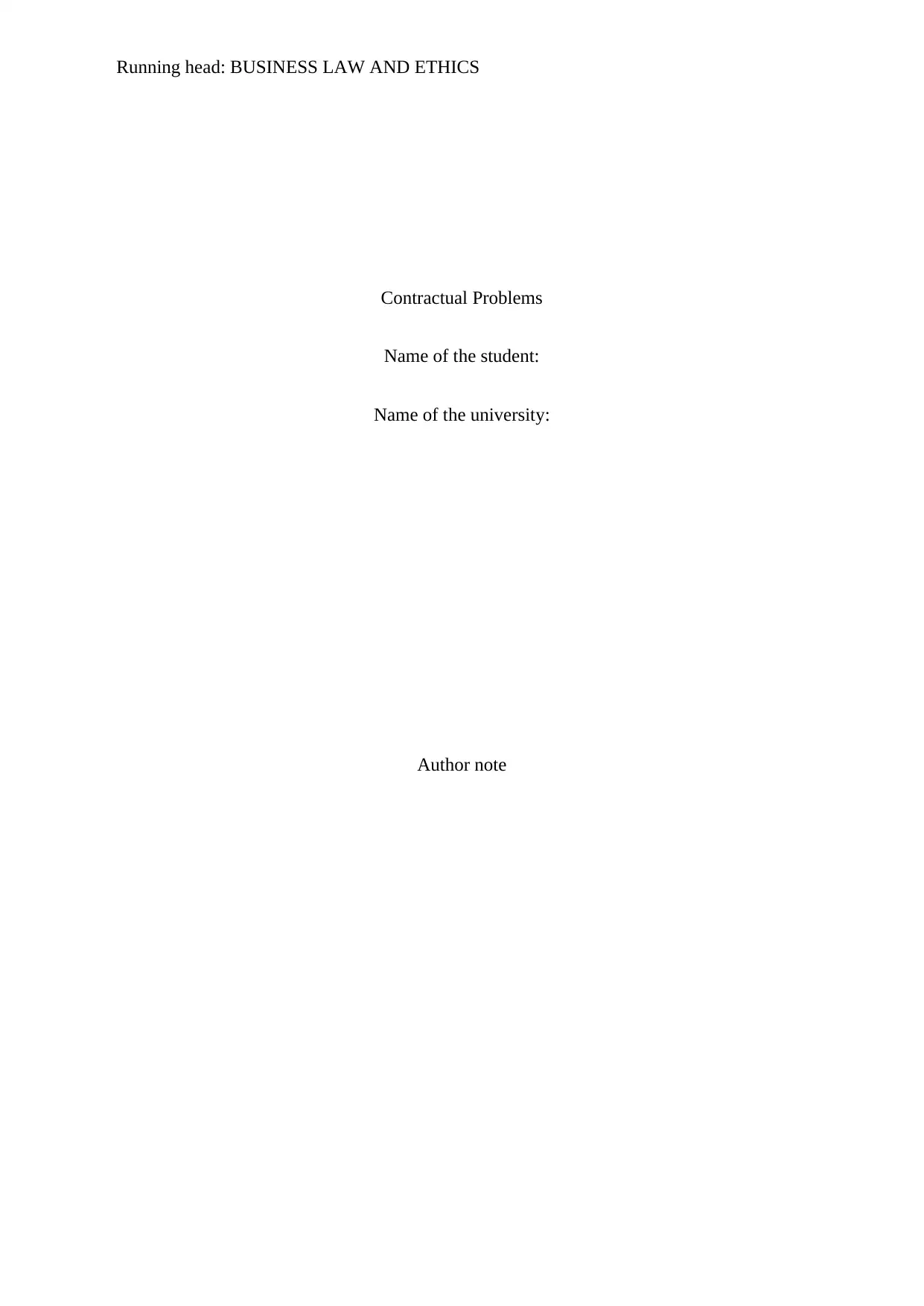
Running head: BUSINESS LAW AND ETHICS
Contractual Problems
Name of the student:
Name of the university:
Author note
Contractual Problems
Name of the student:
Name of the university:
Author note
Paraphrase This Document
Need a fresh take? Get an instant paraphrase of this document with our AI Paraphraser
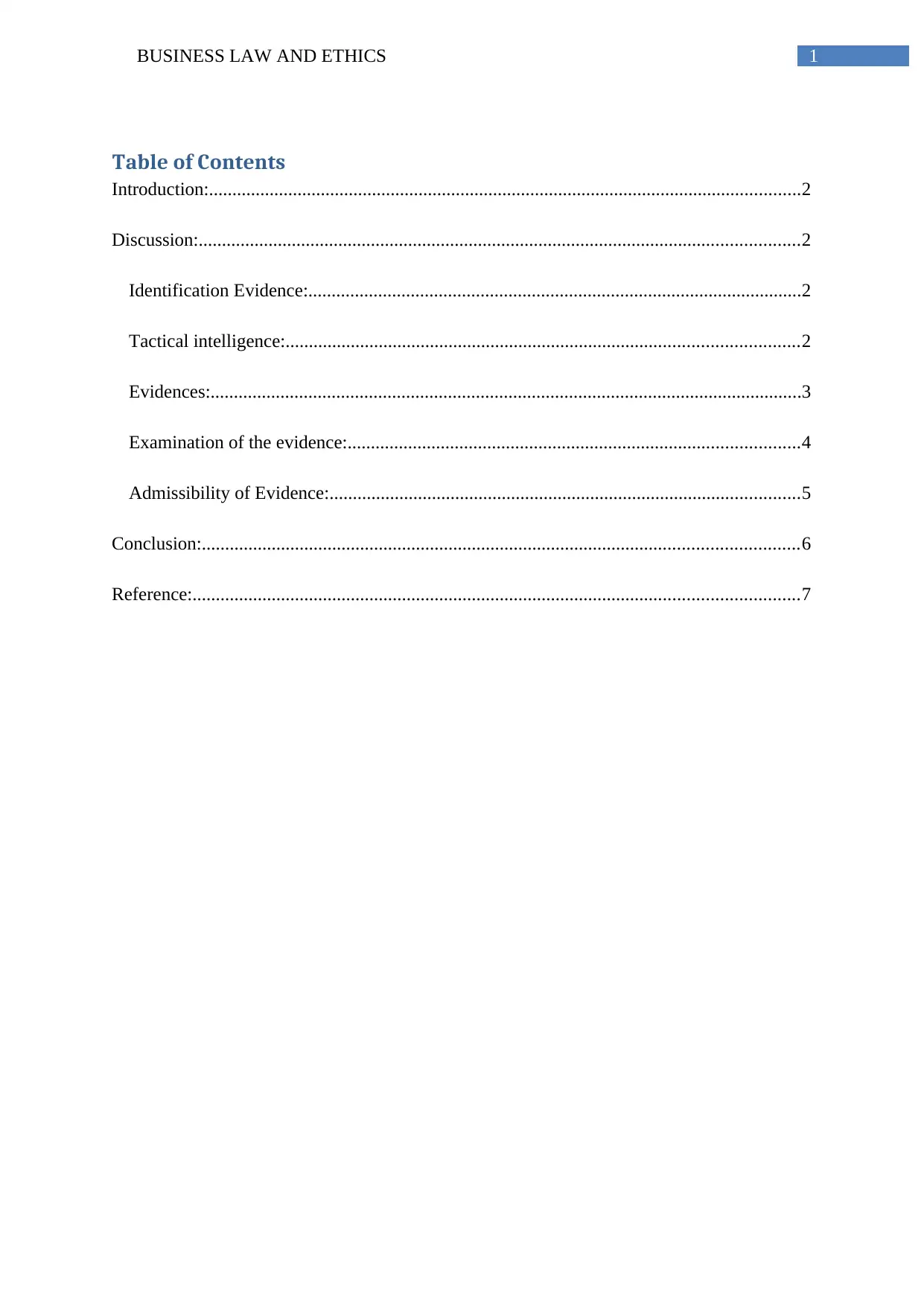
1BUSINESS LAW AND ETHICS
Table of Contents
Introduction:...............................................................................................................................2
Discussion:.................................................................................................................................2
Identification Evidence:..........................................................................................................2
Tactical intelligence:..............................................................................................................2
Evidences:...............................................................................................................................3
Examination of the evidence:.................................................................................................4
Admissibility of Evidence:.....................................................................................................5
Conclusion:................................................................................................................................6
Reference:..................................................................................................................................7
Table of Contents
Introduction:...............................................................................................................................2
Discussion:.................................................................................................................................2
Identification Evidence:..........................................................................................................2
Tactical intelligence:..............................................................................................................2
Evidences:...............................................................................................................................3
Examination of the evidence:.................................................................................................4
Admissibility of Evidence:.....................................................................................................5
Conclusion:................................................................................................................................6
Reference:..................................................................................................................................7
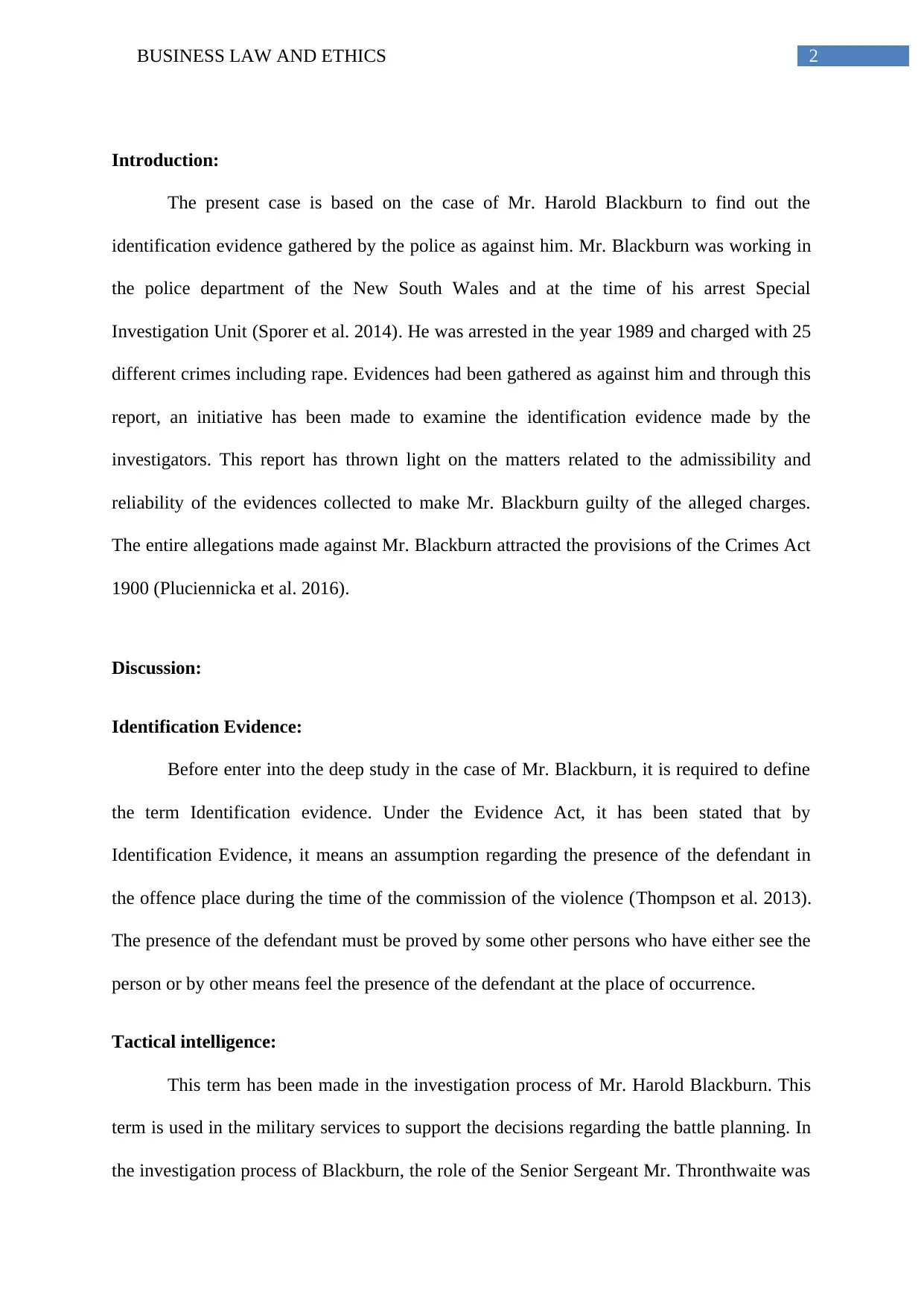
2BUSINESS LAW AND ETHICS
Introduction:
The present case is based on the case of Mr. Harold Blackburn to find out the
identification evidence gathered by the police as against him. Mr. Blackburn was working in
the police department of the New South Wales and at the time of his arrest Special
Investigation Unit (Sporer et al. 2014). He was arrested in the year 1989 and charged with 25
different crimes including rape. Evidences had been gathered as against him and through this
report, an initiative has been made to examine the identification evidence made by the
investigators. This report has thrown light on the matters related to the admissibility and
reliability of the evidences collected to make Mr. Blackburn guilty of the alleged charges.
The entire allegations made against Mr. Blackburn attracted the provisions of the Crimes Act
1900 (Pluciennicka et al. 2016).
Discussion:
Identification Evidence:
Before enter into the deep study in the case of Mr. Blackburn, it is required to define
the term Identification evidence. Under the Evidence Act, it has been stated that by
Identification Evidence, it means an assumption regarding the presence of the defendant in
the offence place during the time of the commission of the violence (Thompson et al. 2013).
The presence of the defendant must be proved by some other persons who have either see the
person or by other means feel the presence of the defendant at the place of occurrence.
Tactical intelligence:
This term has been made in the investigation process of Mr. Harold Blackburn. This
term is used in the military services to support the decisions regarding the battle planning. In
the investigation process of Blackburn, the role of the Senior Sergeant Mr. Thronthwaite was
Introduction:
The present case is based on the case of Mr. Harold Blackburn to find out the
identification evidence gathered by the police as against him. Mr. Blackburn was working in
the police department of the New South Wales and at the time of his arrest Special
Investigation Unit (Sporer et al. 2014). He was arrested in the year 1989 and charged with 25
different crimes including rape. Evidences had been gathered as against him and through this
report, an initiative has been made to examine the identification evidence made by the
investigators. This report has thrown light on the matters related to the admissibility and
reliability of the evidences collected to make Mr. Blackburn guilty of the alleged charges.
The entire allegations made against Mr. Blackburn attracted the provisions of the Crimes Act
1900 (Pluciennicka et al. 2016).
Discussion:
Identification Evidence:
Before enter into the deep study in the case of Mr. Blackburn, it is required to define
the term Identification evidence. Under the Evidence Act, it has been stated that by
Identification Evidence, it means an assumption regarding the presence of the defendant in
the offence place during the time of the commission of the violence (Thompson et al. 2013).
The presence of the defendant must be proved by some other persons who have either see the
person or by other means feel the presence of the defendant at the place of occurrence.
Tactical intelligence:
This term has been made in the investigation process of Mr. Harold Blackburn. This
term is used in the military services to support the decisions regarding the battle planning. In
the investigation process of Blackburn, the role of the Senior Sergeant Mr. Thronthwaite was
⊘ This is a preview!⊘
Do you want full access?
Subscribe today to unlock all pages.

Trusted by 1+ million students worldwide
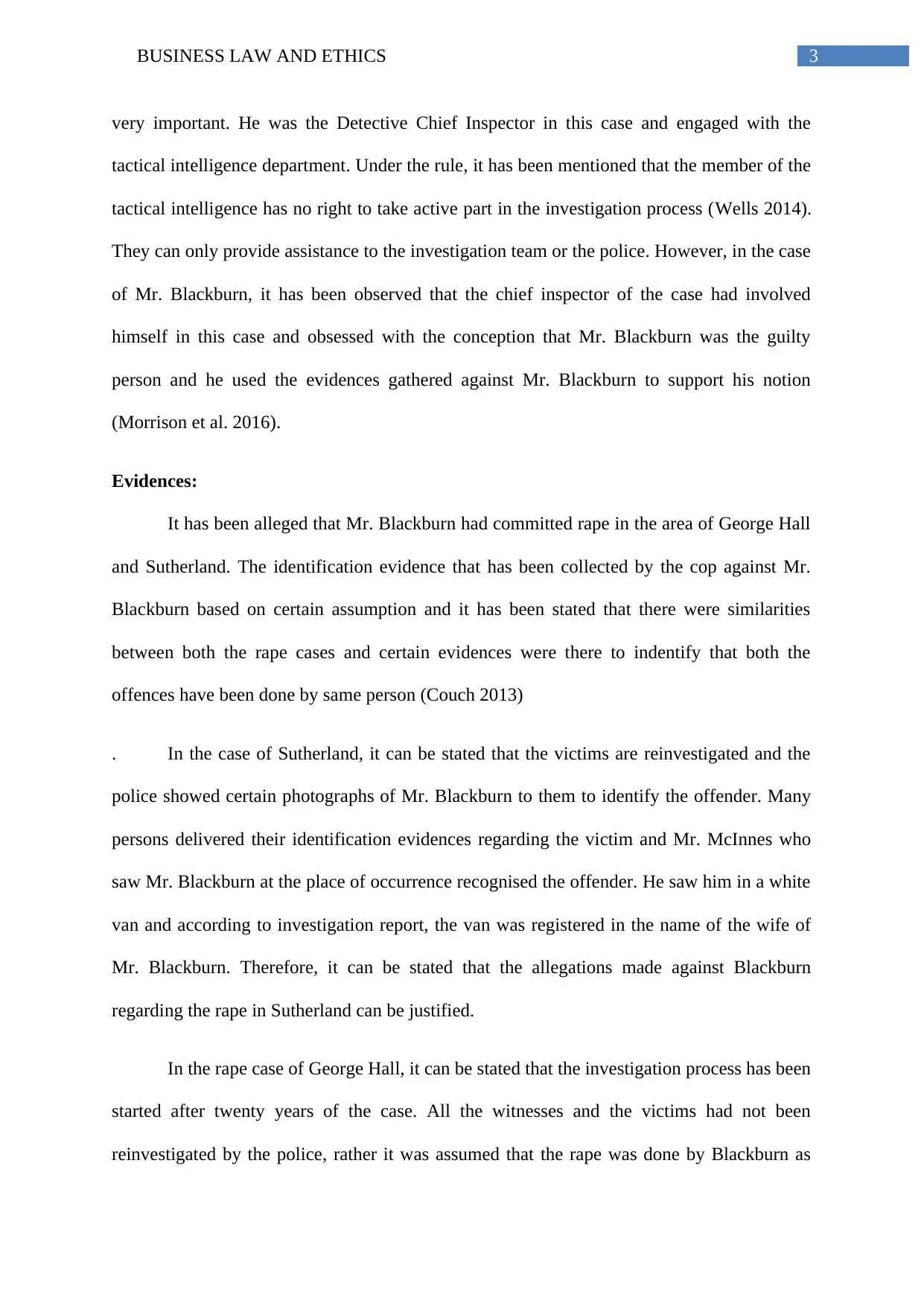
3BUSINESS LAW AND ETHICS
very important. He was the Detective Chief Inspector in this case and engaged with the
tactical intelligence department. Under the rule, it has been mentioned that the member of the
tactical intelligence has no right to take active part in the investigation process (Wells 2014).
They can only provide assistance to the investigation team or the police. However, in the case
of Mr. Blackburn, it has been observed that the chief inspector of the case had involved
himself in this case and obsessed with the conception that Mr. Blackburn was the guilty
person and he used the evidences gathered against Mr. Blackburn to support his notion
(Morrison et al. 2016).
Evidences:
It has been alleged that Mr. Blackburn had committed rape in the area of George Hall
and Sutherland. The identification evidence that has been collected by the cop against Mr.
Blackburn based on certain assumption and it has been stated that there were similarities
between both the rape cases and certain evidences were there to indentify that both the
offences have been done by same person (Couch 2013)
. In the case of Sutherland, it can be stated that the victims are reinvestigated and the
police showed certain photographs of Mr. Blackburn to them to identify the offender. Many
persons delivered their identification evidences regarding the victim and Mr. McInnes who
saw Mr. Blackburn at the place of occurrence recognised the offender. He saw him in a white
van and according to investigation report, the van was registered in the name of the wife of
Mr. Blackburn. Therefore, it can be stated that the allegations made against Blackburn
regarding the rape in Sutherland can be justified.
In the rape case of George Hall, it can be stated that the investigation process has been
started after twenty years of the case. All the witnesses and the victims had not been
reinvestigated by the police, rather it was assumed that the rape was done by Blackburn as
very important. He was the Detective Chief Inspector in this case and engaged with the
tactical intelligence department. Under the rule, it has been mentioned that the member of the
tactical intelligence has no right to take active part in the investigation process (Wells 2014).
They can only provide assistance to the investigation team or the police. However, in the case
of Mr. Blackburn, it has been observed that the chief inspector of the case had involved
himself in this case and obsessed with the conception that Mr. Blackburn was the guilty
person and he used the evidences gathered against Mr. Blackburn to support his notion
(Morrison et al. 2016).
Evidences:
It has been alleged that Mr. Blackburn had committed rape in the area of George Hall
and Sutherland. The identification evidence that has been collected by the cop against Mr.
Blackburn based on certain assumption and it has been stated that there were similarities
between both the rape cases and certain evidences were there to indentify that both the
offences have been done by same person (Couch 2013)
. In the case of Sutherland, it can be stated that the victims are reinvestigated and the
police showed certain photographs of Mr. Blackburn to them to identify the offender. Many
persons delivered their identification evidences regarding the victim and Mr. McInnes who
saw Mr. Blackburn at the place of occurrence recognised the offender. He saw him in a white
van and according to investigation report, the van was registered in the name of the wife of
Mr. Blackburn. Therefore, it can be stated that the allegations made against Blackburn
regarding the rape in Sutherland can be justified.
In the rape case of George Hall, it can be stated that the investigation process has been
started after twenty years of the case. All the witnesses and the victims had not been
reinvestigated by the police, rather it was assumed that the rape was done by Blackburn as
Paraphrase This Document
Need a fresh take? Get an instant paraphrase of this document with our AI Paraphraser
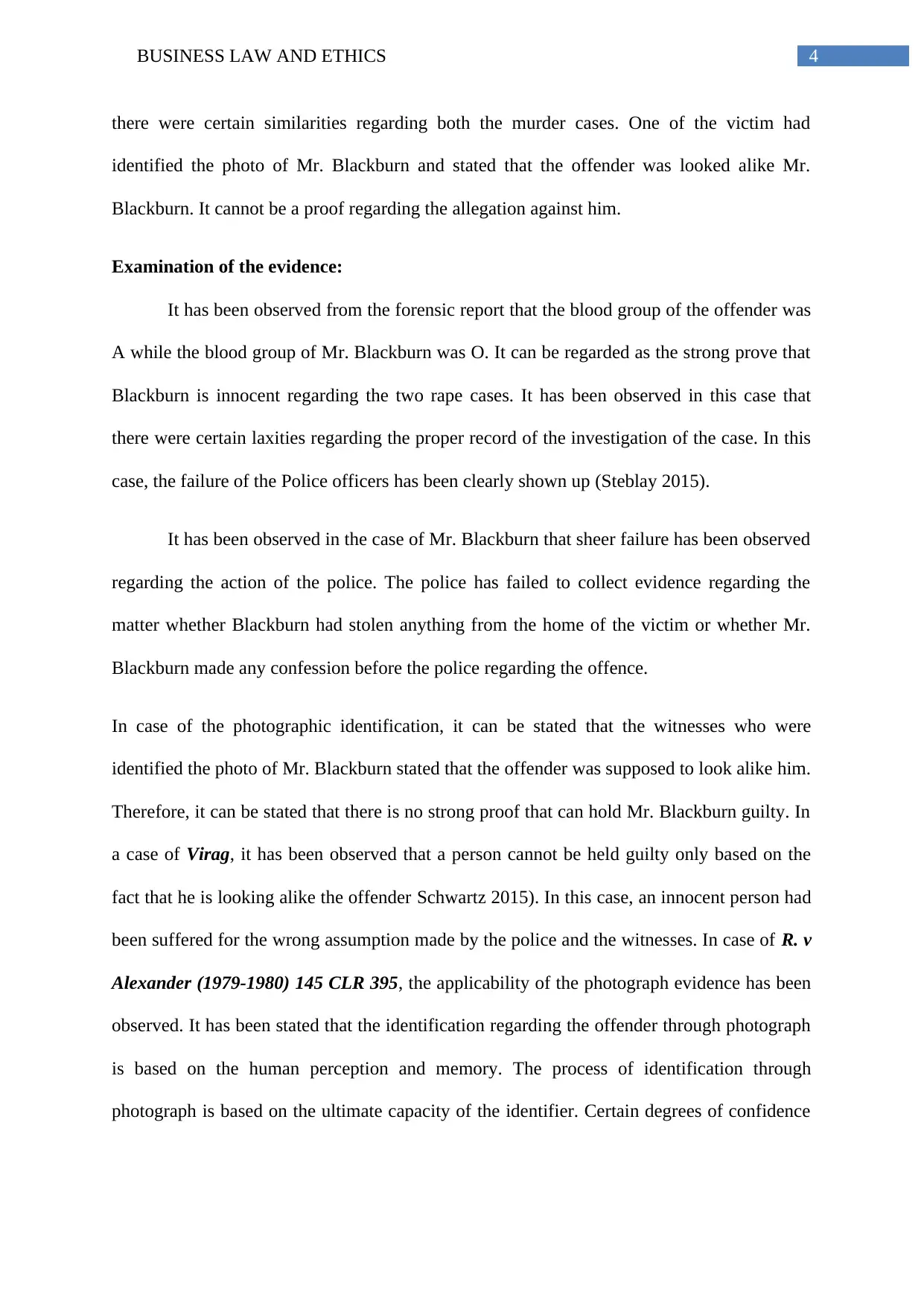
4BUSINESS LAW AND ETHICS
there were certain similarities regarding both the murder cases. One of the victim had
identified the photo of Mr. Blackburn and stated that the offender was looked alike Mr.
Blackburn. It cannot be a proof regarding the allegation against him.
Examination of the evidence:
It has been observed from the forensic report that the blood group of the offender was
A while the blood group of Mr. Blackburn was O. It can be regarded as the strong prove that
Blackburn is innocent regarding the two rape cases. It has been observed in this case that
there were certain laxities regarding the proper record of the investigation of the case. In this
case, the failure of the Police officers has been clearly shown up (Steblay 2015).
It has been observed in the case of Mr. Blackburn that sheer failure has been observed
regarding the action of the police. The police has failed to collect evidence regarding the
matter whether Blackburn had stolen anything from the home of the victim or whether Mr.
Blackburn made any confession before the police regarding the offence.
In case of the photographic identification, it can be stated that the witnesses who were
identified the photo of Mr. Blackburn stated that the offender was supposed to look alike him.
Therefore, it can be stated that there is no strong proof that can hold Mr. Blackburn guilty. In
a case of Virag, it has been observed that a person cannot be held guilty only based on the
fact that he is looking alike the offender Schwartz 2015). In this case, an innocent person had
been suffered for the wrong assumption made by the police and the witnesses. In case of R. v
Alexander (1979-1980) 145 CLR 395, the applicability of the photograph evidence has been
observed. It has been stated that the identification regarding the offender through photograph
is based on the human perception and memory. The process of identification through
photograph is based on the ultimate capacity of the identifier. Certain degrees of confidence
there were certain similarities regarding both the murder cases. One of the victim had
identified the photo of Mr. Blackburn and stated that the offender was looked alike Mr.
Blackburn. It cannot be a proof regarding the allegation against him.
Examination of the evidence:
It has been observed from the forensic report that the blood group of the offender was
A while the blood group of Mr. Blackburn was O. It can be regarded as the strong prove that
Blackburn is innocent regarding the two rape cases. It has been observed in this case that
there were certain laxities regarding the proper record of the investigation of the case. In this
case, the failure of the Police officers has been clearly shown up (Steblay 2015).
It has been observed in the case of Mr. Blackburn that sheer failure has been observed
regarding the action of the police. The police has failed to collect evidence regarding the
matter whether Blackburn had stolen anything from the home of the victim or whether Mr.
Blackburn made any confession before the police regarding the offence.
In case of the photographic identification, it can be stated that the witnesses who were
identified the photo of Mr. Blackburn stated that the offender was supposed to look alike him.
Therefore, it can be stated that there is no strong proof that can hold Mr. Blackburn guilty. In
a case of Virag, it has been observed that a person cannot be held guilty only based on the
fact that he is looking alike the offender Schwartz 2015). In this case, an innocent person had
been suffered for the wrong assumption made by the police and the witnesses. In case of R. v
Alexander (1979-1980) 145 CLR 395, the applicability of the photograph evidence has been
observed. It has been stated that the identification regarding the offender through photograph
is based on the human perception and memory. The process of identification through
photograph is based on the ultimate capacity of the identifier. Certain degrees of confidence
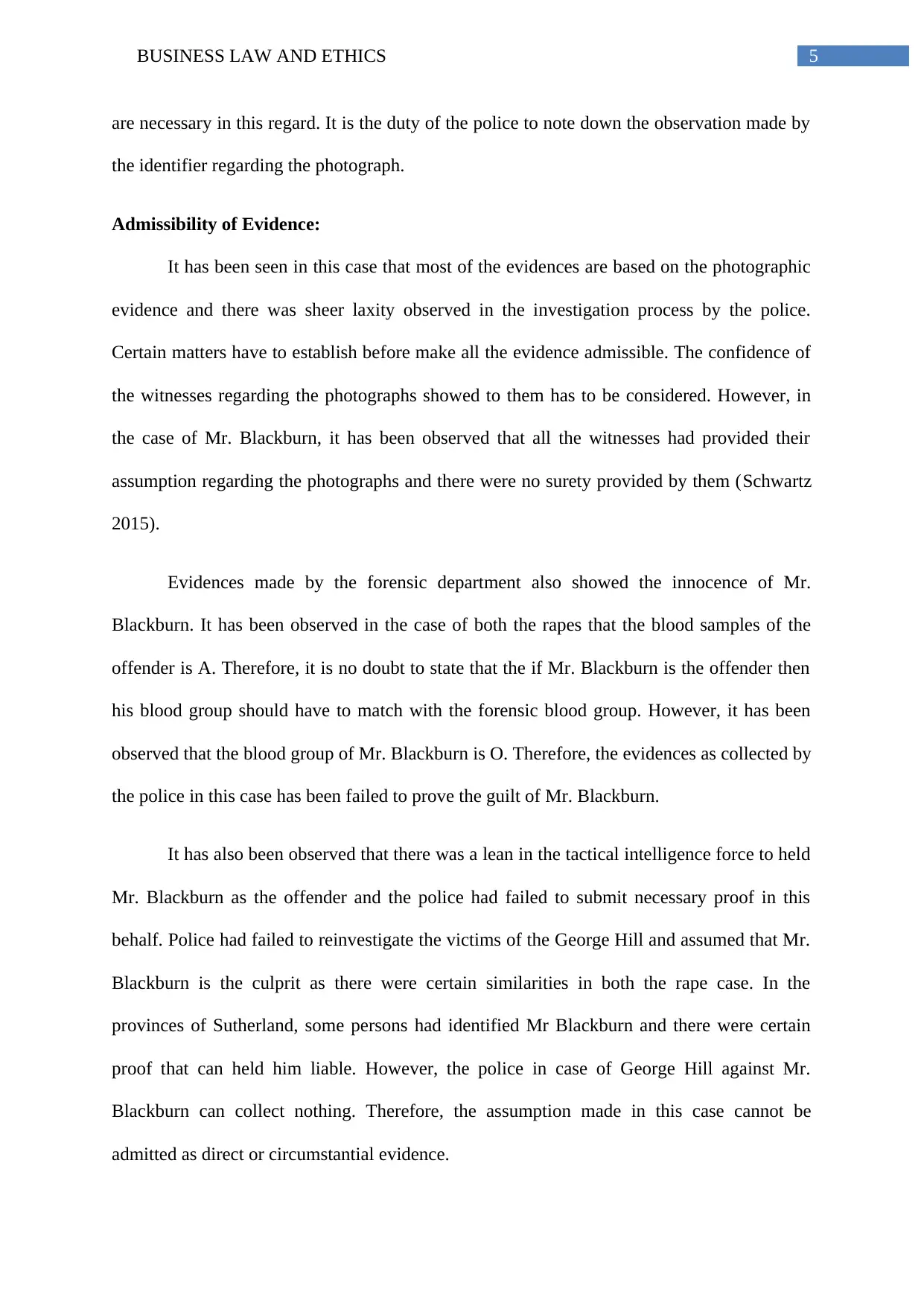
5BUSINESS LAW AND ETHICS
are necessary in this regard. It is the duty of the police to note down the observation made by
the identifier regarding the photograph.
Admissibility of Evidence:
It has been seen in this case that most of the evidences are based on the photographic
evidence and there was sheer laxity observed in the investigation process by the police.
Certain matters have to establish before make all the evidence admissible. The confidence of
the witnesses regarding the photographs showed to them has to be considered. However, in
the case of Mr. Blackburn, it has been observed that all the witnesses had provided their
assumption regarding the photographs and there were no surety provided by them (Schwartz
2015).
Evidences made by the forensic department also showed the innocence of Mr.
Blackburn. It has been observed in the case of both the rapes that the blood samples of the
offender is A. Therefore, it is no doubt to state that the if Mr. Blackburn is the offender then
his blood group should have to match with the forensic blood group. However, it has been
observed that the blood group of Mr. Blackburn is O. Therefore, the evidences as collected by
the police in this case has been failed to prove the guilt of Mr. Blackburn.
It has also been observed that there was a lean in the tactical intelligence force to held
Mr. Blackburn as the offender and the police had failed to submit necessary proof in this
behalf. Police had failed to reinvestigate the victims of the George Hill and assumed that Mr.
Blackburn is the culprit as there were certain similarities in both the rape case. In the
provinces of Sutherland, some persons had identified Mr Blackburn and there were certain
proof that can held him liable. However, the police in case of George Hill against Mr.
Blackburn can collect nothing. Therefore, the assumption made in this case cannot be
admitted as direct or circumstantial evidence.
are necessary in this regard. It is the duty of the police to note down the observation made by
the identifier regarding the photograph.
Admissibility of Evidence:
It has been seen in this case that most of the evidences are based on the photographic
evidence and there was sheer laxity observed in the investigation process by the police.
Certain matters have to establish before make all the evidence admissible. The confidence of
the witnesses regarding the photographs showed to them has to be considered. However, in
the case of Mr. Blackburn, it has been observed that all the witnesses had provided their
assumption regarding the photographs and there were no surety provided by them (Schwartz
2015).
Evidences made by the forensic department also showed the innocence of Mr.
Blackburn. It has been observed in the case of both the rapes that the blood samples of the
offender is A. Therefore, it is no doubt to state that the if Mr. Blackburn is the offender then
his blood group should have to match with the forensic blood group. However, it has been
observed that the blood group of Mr. Blackburn is O. Therefore, the evidences as collected by
the police in this case has been failed to prove the guilt of Mr. Blackburn.
It has also been observed that there was a lean in the tactical intelligence force to held
Mr. Blackburn as the offender and the police had failed to submit necessary proof in this
behalf. Police had failed to reinvestigate the victims of the George Hill and assumed that Mr.
Blackburn is the culprit as there were certain similarities in both the rape case. In the
provinces of Sutherland, some persons had identified Mr Blackburn and there were certain
proof that can held him liable. However, the police in case of George Hill against Mr.
Blackburn can collect nothing. Therefore, the assumption made in this case cannot be
admitted as direct or circumstantial evidence.
⊘ This is a preview!⊘
Do you want full access?
Subscribe today to unlock all pages.

Trusted by 1+ million students worldwide
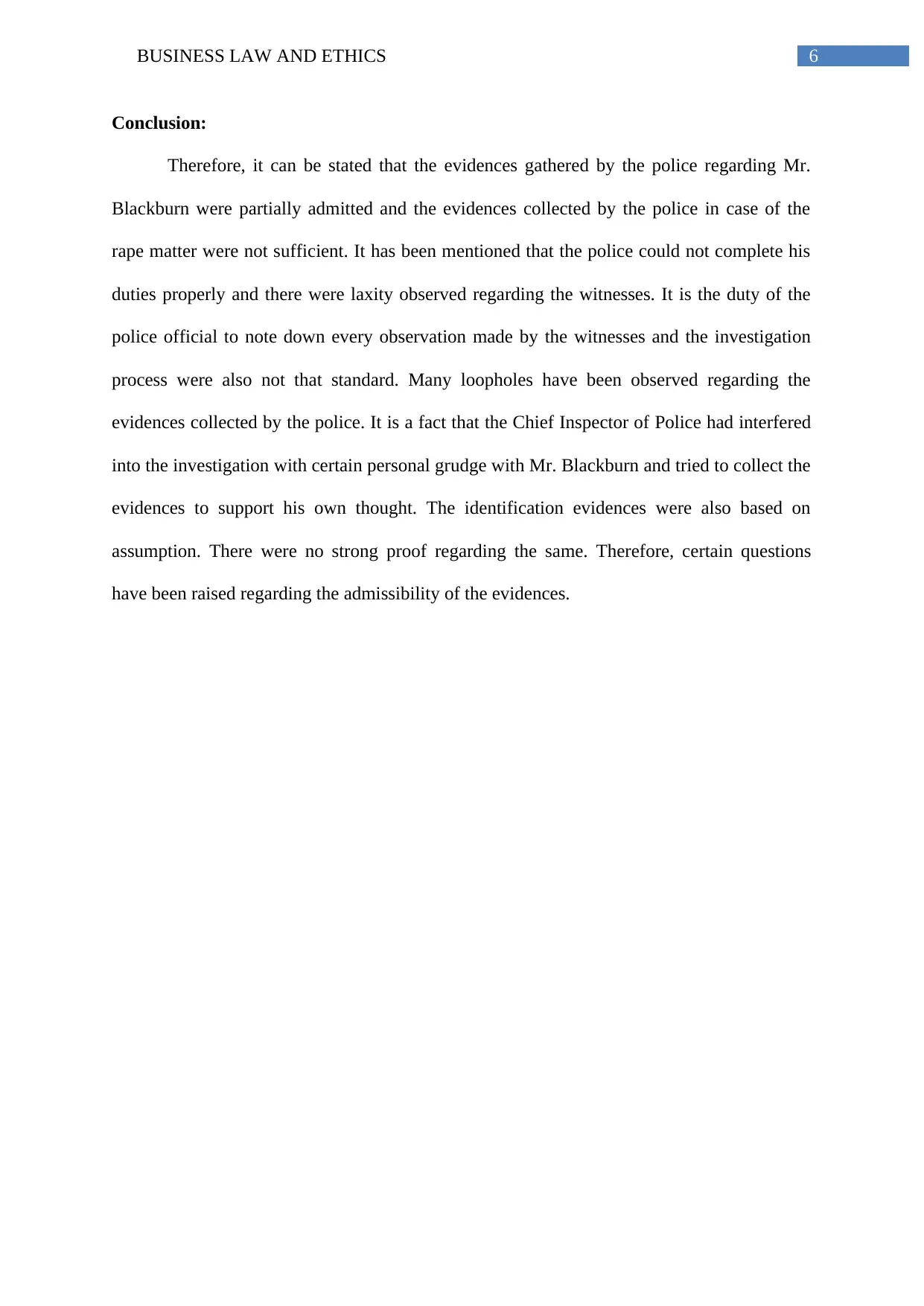
6BUSINESS LAW AND ETHICS
Conclusion:
Therefore, it can be stated that the evidences gathered by the police regarding Mr.
Blackburn were partially admitted and the evidences collected by the police in case of the
rape matter were not sufficient. It has been mentioned that the police could not complete his
duties properly and there were laxity observed regarding the witnesses. It is the duty of the
police official to note down every observation made by the witnesses and the investigation
process were also not that standard. Many loopholes have been observed regarding the
evidences collected by the police. It is a fact that the Chief Inspector of Police had interfered
into the investigation with certain personal grudge with Mr. Blackburn and tried to collect the
evidences to support his own thought. The identification evidences were also based on
assumption. There were no strong proof regarding the same. Therefore, certain questions
have been raised regarding the admissibility of the evidences.
Conclusion:
Therefore, it can be stated that the evidences gathered by the police regarding Mr.
Blackburn were partially admitted and the evidences collected by the police in case of the
rape matter were not sufficient. It has been mentioned that the police could not complete his
duties properly and there were laxity observed regarding the witnesses. It is the duty of the
police official to note down every observation made by the witnesses and the investigation
process were also not that standard. Many loopholes have been observed regarding the
evidences collected by the police. It is a fact that the Chief Inspector of Police had interfered
into the investigation with certain personal grudge with Mr. Blackburn and tried to collect the
evidences to support his own thought. The identification evidences were also based on
assumption. There were no strong proof regarding the same. Therefore, certain questions
have been raised regarding the admissibility of the evidences.
Paraphrase This Document
Need a fresh take? Get an instant paraphrase of this document with our AI Paraphraser
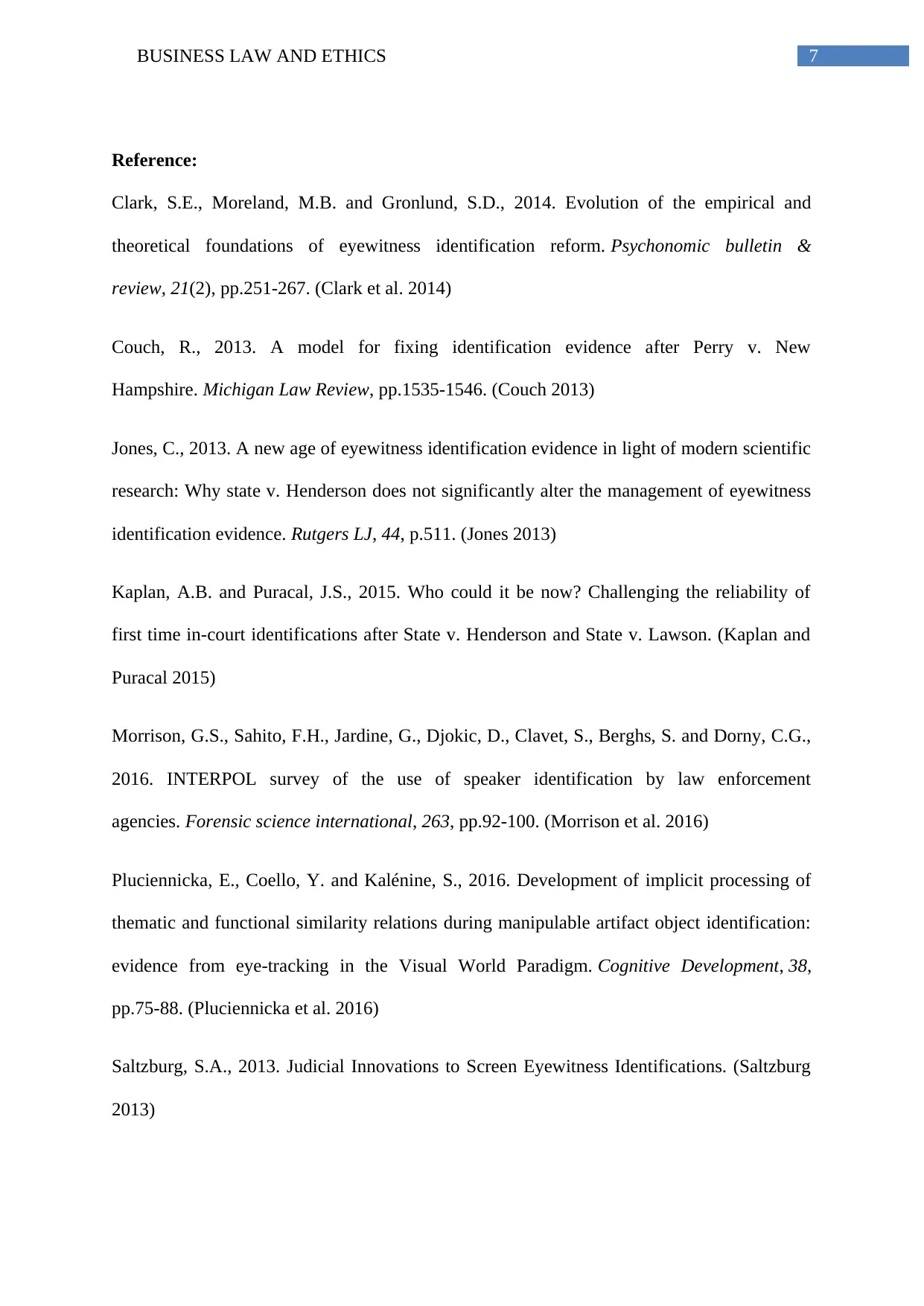
7BUSINESS LAW AND ETHICS
Reference:
Clark, S.E., Moreland, M.B. and Gronlund, S.D., 2014. Evolution of the empirical and
theoretical foundations of eyewitness identification reform. Psychonomic bulletin &
review, 21(2), pp.251-267. (Clark et al. 2014)
Couch, R., 2013. A model for fixing identification evidence after Perry v. New
Hampshire. Michigan Law Review, pp.1535-1546. (Couch 2013)
Jones, C., 2013. A new age of eyewitness identification evidence in light of modern scientific
research: Why state v. Henderson does not significantly alter the management of eyewitness
identification evidence. Rutgers LJ, 44, p.511. (Jones 2013)
Kaplan, A.B. and Puracal, J.S., 2015. Who could it be now? Challenging the reliability of
first time in-court identifications after State v. Henderson and State v. Lawson. (Kaplan and
Puracal 2015)
Morrison, G.S., Sahito, F.H., Jardine, G., Djokic, D., Clavet, S., Berghs, S. and Dorny, C.G.,
2016. INTERPOL survey of the use of speaker identification by law enforcement
agencies. Forensic science international, 263, pp.92-100. (Morrison et al. 2016)
Pluciennicka, E., Coello, Y. and Kalénine, S., 2016. Development of implicit processing of
thematic and functional similarity relations during manipulable artifact object identification:
evidence from eye-tracking in the Visual World Paradigm. Cognitive Development, 38,
pp.75-88. (Pluciennicka et al. 2016)
Saltzburg, S.A., 2013. Judicial Innovations to Screen Eyewitness Identifications. (Saltzburg
2013)
Reference:
Clark, S.E., Moreland, M.B. and Gronlund, S.D., 2014. Evolution of the empirical and
theoretical foundations of eyewitness identification reform. Psychonomic bulletin &
review, 21(2), pp.251-267. (Clark et al. 2014)
Couch, R., 2013. A model for fixing identification evidence after Perry v. New
Hampshire. Michigan Law Review, pp.1535-1546. (Couch 2013)
Jones, C., 2013. A new age of eyewitness identification evidence in light of modern scientific
research: Why state v. Henderson does not significantly alter the management of eyewitness
identification evidence. Rutgers LJ, 44, p.511. (Jones 2013)
Kaplan, A.B. and Puracal, J.S., 2015. Who could it be now? Challenging the reliability of
first time in-court identifications after State v. Henderson and State v. Lawson. (Kaplan and
Puracal 2015)
Morrison, G.S., Sahito, F.H., Jardine, G., Djokic, D., Clavet, S., Berghs, S. and Dorny, C.G.,
2016. INTERPOL survey of the use of speaker identification by law enforcement
agencies. Forensic science international, 263, pp.92-100. (Morrison et al. 2016)
Pluciennicka, E., Coello, Y. and Kalénine, S., 2016. Development of implicit processing of
thematic and functional similarity relations during manipulable artifact object identification:
evidence from eye-tracking in the Visual World Paradigm. Cognitive Development, 38,
pp.75-88. (Pluciennicka et al. 2016)
Saltzburg, S.A., 2013. Judicial Innovations to Screen Eyewitness Identifications. (Saltzburg
2013)
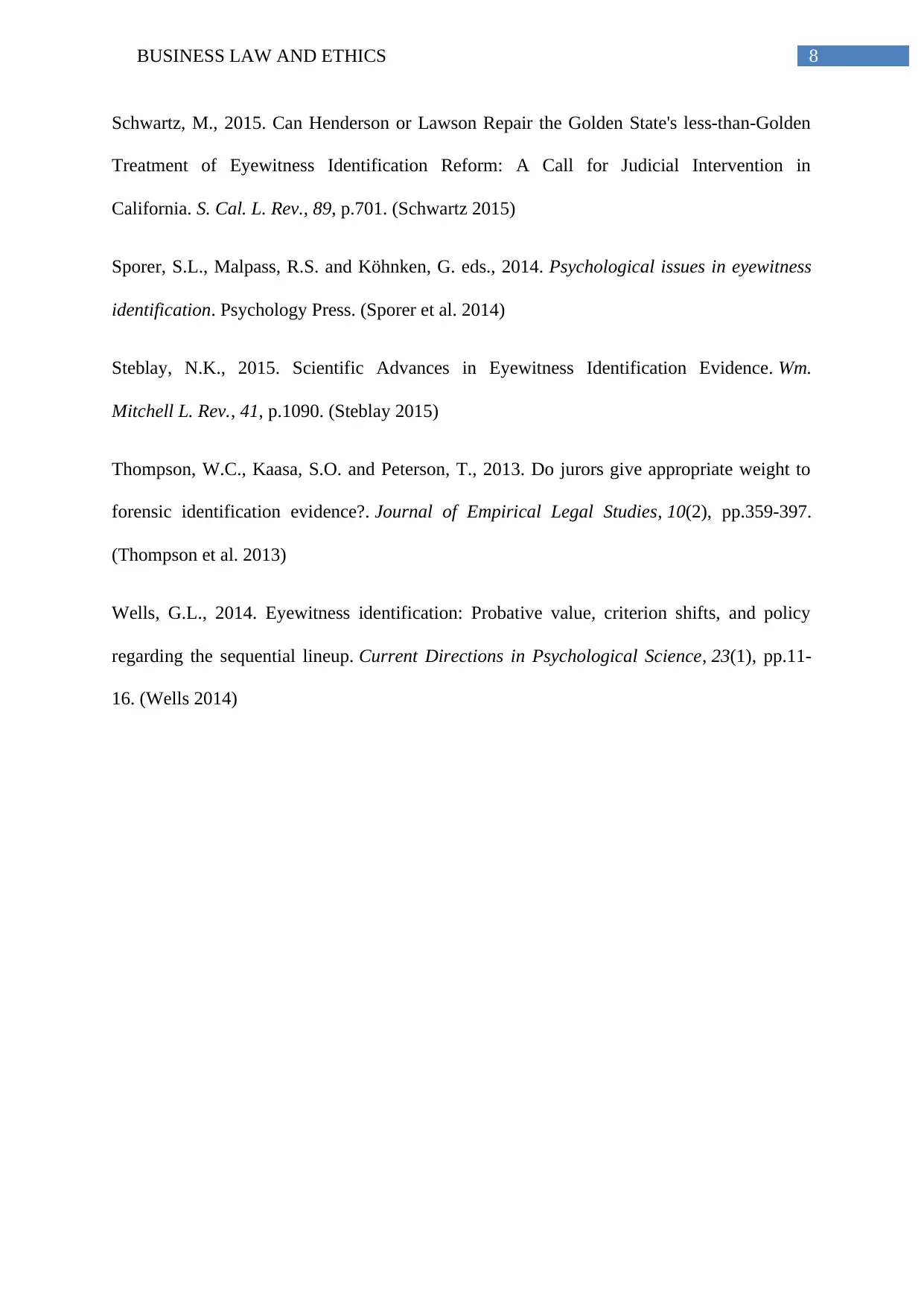
8BUSINESS LAW AND ETHICS
Schwartz, M., 2015. Can Henderson or Lawson Repair the Golden State's less-than-Golden
Treatment of Eyewitness Identification Reform: A Call for Judicial Intervention in
California. S. Cal. L. Rev., 89, p.701. (Schwartz 2015)
Sporer, S.L., Malpass, R.S. and Köhnken, G. eds., 2014. Psychological issues in eyewitness
identification. Psychology Press. (Sporer et al. 2014)
Steblay, N.K., 2015. Scientific Advances in Eyewitness Identification Evidence. Wm.
Mitchell L. Rev., 41, p.1090. (Steblay 2015)
Thompson, W.C., Kaasa, S.O. and Peterson, T., 2013. Do jurors give appropriate weight to
forensic identification evidence?. Journal of Empirical Legal Studies, 10(2), pp.359-397.
(Thompson et al. 2013)
Wells, G.L., 2014. Eyewitness identification: Probative value, criterion shifts, and policy
regarding the sequential lineup. Current Directions in Psychological Science, 23(1), pp.11-
16. (Wells 2014)
Schwartz, M., 2015. Can Henderson or Lawson Repair the Golden State's less-than-Golden
Treatment of Eyewitness Identification Reform: A Call for Judicial Intervention in
California. S. Cal. L. Rev., 89, p.701. (Schwartz 2015)
Sporer, S.L., Malpass, R.S. and Köhnken, G. eds., 2014. Psychological issues in eyewitness
identification. Psychology Press. (Sporer et al. 2014)
Steblay, N.K., 2015. Scientific Advances in Eyewitness Identification Evidence. Wm.
Mitchell L. Rev., 41, p.1090. (Steblay 2015)
Thompson, W.C., Kaasa, S.O. and Peterson, T., 2013. Do jurors give appropriate weight to
forensic identification evidence?. Journal of Empirical Legal Studies, 10(2), pp.359-397.
(Thompson et al. 2013)
Wells, G.L., 2014. Eyewitness identification: Probative value, criterion shifts, and policy
regarding the sequential lineup. Current Directions in Psychological Science, 23(1), pp.11-
16. (Wells 2014)
⊘ This is a preview!⊘
Do you want full access?
Subscribe today to unlock all pages.

Trusted by 1+ million students worldwide
1 out of 9
Related Documents
Your All-in-One AI-Powered Toolkit for Academic Success.
+13062052269
info@desklib.com
Available 24*7 on WhatsApp / Email
![[object Object]](/_next/static/media/star-bottom.7253800d.svg)
Unlock your academic potential
Copyright © 2020–2025 A2Z Services. All Rights Reserved. Developed and managed by ZUCOL.




